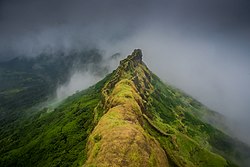This article needs additional citations for verification. (November 2021) |
Rajgad (literal meaning ruling fort) is a Hill region fort situated in the Pune district of Maharashtra, India. Formerly known as Murumbdev, the fort was the first capital of the Maratha Empire under the rule of Chhatrapati Shivaji for almost 26 years, after which the capital was moved to the Raigad Fort.[1] Treasures discovered from an adjacent fort called Torna were used to completely build and fortify the Rajgad Fort.[citation needed]
| Rajgad Fort | |
|---|---|
| Part of on Maharashtra | |
| Pune District, Maharashtra | |
 Rajgad Fort | |
Shown within Maharashtra | |
| Coordinates | 18°14′46″N 73°40′56″E / 18.2459862°N 73.6821929°E |
| Type | Hill fort |
| Height | 1376 m |
| Site information | |
| Owner |
|
| Open to the public | Yes |
| Site history | |
| Architect | Chhatrapati Shivaji Maharaj |
The Rajgad Fort is located around 60 km (37 mi) to the south-west of Pune and about 15 km (9.3 mi) west of Nasrapur in the Sahyadris range. The fort lies 1,376 m (4,514 ft) above the sea level. The diameter of the base of the fort was about 40 km (25 mi) which made it difficult to lay siege on it, which added to its strategic value. The fort's ruins consist of palaces, water cisterns, and caves. This fort was built on a hill called Murumbadevi Dongar (mountain of the goddess Murumba). Rajgad boasts of the highest number of days stayed by Chhatrapati Shivaji on any fort. [citation needed]
History edit
The fort has stood witness to many significant historic events including the birth of Chhatrapati Shivaji's son Rajaram I, the death of Shivaji's wife Saibai, the return of Shivaji from Agra, the burial of Afzal Khan's head in the Mahadarwaja walls of Balle Killa, the strict words of Sonopant Dabir to Shivaji.[citation needed]
The Rajgad Fort was also one of the 12 forts that Shivaji kept when he signed the Treaty of Purandar in 1665, with the Mughal general Jai Singh I, leader of the Mughal forces. Under this treaty, 23 forts were handed over to the Mughals.[2]
List of chronological events edit
| 1647 | Chhatrapati Shivaji Maharaj captured the fort. | |
| 1649 | Repairs on the fort began and Shamrao Neelkanth Ranzekar was appointed as the Peshwa. | |
| 1654 | The fort was renamed as "Rajgad". Construction on new fortifications and buildings commenced. | |
| 1658 | 14 January | Chhatrapati Shivaji Maharaj returned to Rajgad after conquering North Konkan. |
| 1659 | 11 July | Chhatrapati Shivaji Maharaj shifted to Pratapgad in order to battle with Afzal Khan. |
| 1659 | 5 September | Maharani Saibai (Chhatrapati Shivaji Maharaj's wife) died in the Rajgad Fort. |
| 1660 | July | Chhatrapati Shivaji Maharaj escaped from Siddi Jouhar's siege of Panhala and came to Rajgad. |
| 1661 | July | The idol of Bhavanimata, which was to be established in Pratapgad, was first brought to Rajgad to be inspected by Jijabai. |
| 1662 | January | The construction of the Rajgad fort was completed and Chhatrapati Shivaji Maharaj returned to the fort after capturing Pen and Kalyan. |
| 1664 | February | The booty of Surat was brought to Rajgad. |
| 1665 | 30 April | The Mughals were unsuccessful on their attack of the fort. |
| 1665 | June | Chhatrapati Shivaji Maharaj's letter of accepting defeat was sent to Jaisingh. |
| 1670 | 24 February | Rajaram was born on the Fort. |
| 1671 | The repairing of the fort began at an expected cost of 10,000 hons. | |
| 1674 | 6 June | Coronation of Chhatrapati Shivaji Maharaj happened on Riagard Fort [citation needed] |
| 1689 | June | The fort was captured by the Mughals after Sambhaji was murdered. |
| 1692 | Shankarji Narayan captured the fort from the Mughals. | |
| 1697 | Rajaram returned to Maharashtra and made Rajgad his new capital[1] | |
| 1701 | 4 August | Shahaji Mohite was made the havaldar of Padmavati Machi |
| 1704 | 18 February | The fort was handed over to Aurangzeb as part of a treaty. The fort was renamed to Nabishahagad. Sidojirao Thopte and Santaji Shilimkar were killed here by Aurangzeb. |
| 1707 | 29 May | Gunaji Sawant captured the fort and The Maratha War of Independence ended. |
| 1709 | Shahu made provisions for the repairs of the fort. | |
| 1818 | The Rajgad Fort passed into the hands of the British. |
Tourism edit
The fort is a significant tourist destination and is most sought after especially during monsoon. Visitors prefer to stay overnight on the fort considering the fort itself is huge and cannot be explored in a single day. The Padmavati temple on the fort can accommodate around 50 people. Water tanks provide fresh water all throughout the year. Villagers from the foothills of Rajgad sell local antiques and items to these tourists.
Gallery edit
- The Fort
- Bale Killa, Rajgad
- Ballekilla, Rajgad
- Sanjivani Machi-view from Rajgad Mahadwar
- Rajgad
- Nedha- TheNeedle Head of Fort Rajgad 01
See also edit
References edit
- ^ a b Prof. A. R. Kulkarni (1 July 2008). "Rajgad: The first capital of Chatrapati Shivaji Maharaj". Medieval Maratha Country. Diamond Publications. ISBN 978-81-8483-072-9.
- ^ "Rajgarh Fort History". Travelomy. Retrieved 8 February 2012.
External links edit
















